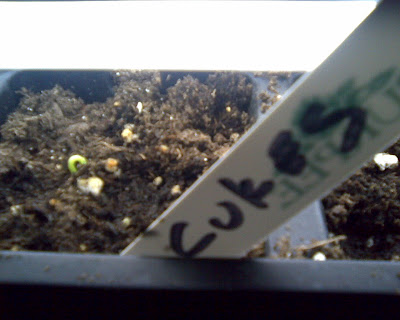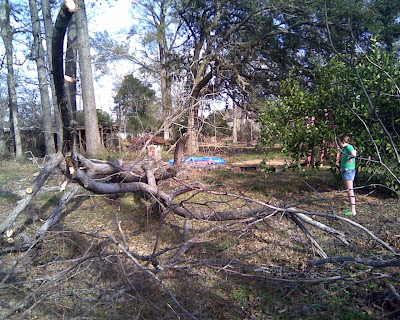One thing leads to another. And another. But it's all good, in the end.
Hurricane Gustav's ravages led us to decide to add more fruit trees to the back corner of the yard. (Downed trees and limbs opened up the area to the sun.)
That, in turn, led to cutting down a 75-foot water oak. (Had to eliminate even more shade.)
Looking at that felled oak led me to make my own lump charcoal. (I couldn't stand to see all that oak decompose around the brush pile.)
We have no fireplace – this is South Louisiana – but we DO have a wood- and charcoal-burning grill. I’d already cut, split and stacked enough hurricane debris to last at least two years of grilling and smoking. Cutting that water oak into firewood would be an exercise in futility. In our climate, even oak would rot long before it ever hit the grill.
Because it won't rot, I decided to make charcoal, lump charcoal.

Lump is the term for natural charcoal as opposed to the manufactured briquettes under well-advertised brand names that crowd supermarket shelves. Lump is pure wood. It burns clean and leaves nothing but ash. Almost every briquette is made from charcoal dust mixed with binders and other noxious chemicals.
I’m an avid outdoor cook – rain or shine, steaming or freezing -- and I switched to store-bought lump charcoal for grilling and smoking a few years ago. Reading about charcoal on the Internet, I’d stumbled across ways to make it
yourself.
As I took my chainsaw to that downed oak, I flashed back on the idea of making my own charcoal. Ah, the Internet: a source of endless knowledge and even more diversion. A search instantly turned up a half-dozen techniques for small-scale charcoal making. I also spent hours reading about -- and watching videos of – old-fashioned and large scale charcoal making. I’ll spare you all the details.
Making lump charcoal is a simple concept: burn wood in a smoldering fire with limited oxygen. When all the water vapor, tars, gasses and other organic compounds are burned off, cut off ALL the air. After it cools for a day, you’ll have nothing but carbon: charcoal.
I settled on the easiest method that needed the least equipment but made the most smoke. (More on that in later post.) I bought a recycled and reconditioned 55-gallon drum with a removable lid. I bought four fire bricks, the kind that line fireplaces, and cold chisel. Total cost: about $50.
I used the cold chisel (never knew such a thing existed) to cut five, 2-inch holes in the bottom of the barrel. Hammering hard enough to cut a barrel to cut through steel is a loud and violent process.
Here’s the short version of making charcoal in a 55-gallon drum. I set the newly ventilated drum on the four bricks, piled newspapers and kindling on the bottom then filled it with chunks of water oak and lit it from below. Once the fire was crackling along nicely, I slapped the lid on top and propped it open with a piece of steel reinforcing bar. Then I shoveled dirt around the bottom to cut off the air flow except for a four-inch hole.
Then I let I burn.

Or, more accurately, smolder. That went on for about four hours, pumping out a steady cloud of thick, white smoke. (More on that in a later post.) Once the smoke thinned out – signifying the conversion to charcoal was largely complete – I sealed the lid and used dirt to cut off the air flow from below.
And I waited. For 18 hours. Needed plenty of time for all the coals to die out and the batch to cool down. The next afternoon, I headed back there like a kid heading for his stocking on Christmas morning. What would I find inside.
It
wasn’t great but could have been worse.
The barrel –once filled to the top – was now less than half full. I stopped the burn a little early and about a third was only half burned – or brands, as we charcoal makers say. No problem. I set them aside for the next batch.

I sorted and sifted and sacked up about 15 pounds of quality, pure charcoal. I was quite delighted with myself. It worked and I would make more.
Now, the hard work began: cutting and splitting the rest of a 75-foot oak into small pieces. It was far more effort than cutting it into 2-foot chunks and hauling them to the brush pile.
But, I’
ve come to love that work. Growing up, my family had mountain cabin in Virginia heated by wood. I was raised using chainsaws, axes, sledges and wedges. Back then, it was just work. Now, much later in life I can to appreciate the joys of felling trees, splitting logs and stacking firewood. (My 12- and 14-year-old daughters, however, do not share my appreciation for a well-stack wood pile.)
Rather than go the easy route and leave the oak to rot and get on with planting the orchard, I took the tough road. I sliced the trunk into six-inch disks and cut any limb thicker than 2 inches into
manageable lengths and stacked them all.
Then came the splitting. What was once a chore had become something I looked forward to. Before we turned our clocks back, I had time to change clothes after work and split a few rounds. If found a sense of accomplishment in filling bins and stacks with the split wood. (By Christmas, two and a half months after the tree went down, it was all split.)
Speaking of Christmas ... we actually gave charcoal for presents this year, but more on that later.










